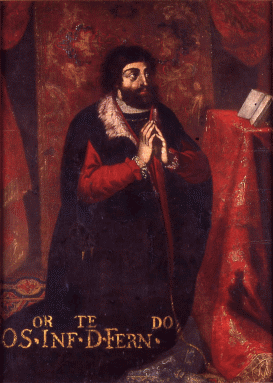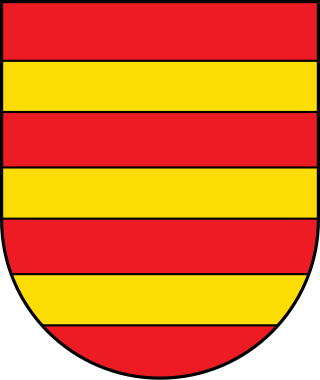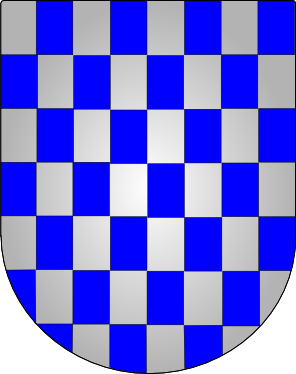
The Most Serene House of Braganza, also known as the Brigantine dynasty, is a dynasty of emperors, kings, princes, and dukes of Portuguese origin which reigned in Europe and the Americas.

John of Portugal, occasionally surnamed Castro, was the eldest surviving son of King Peter I of Portugal by his mistress Inês de Castro. He was a potential but unsuccessful contender for the Portuguese throne during the 1383–85 crisis of succession.

Infante Ferdinand, Duke of Viseu and Beja was the third son of Edward, King of Portugal and his wife Eleanor of Aragon.
Constable of Portugal was an office created by King Ferdinand I of Portugal in 1382, to substitute the High Standard-bearer (Alferes-Mor) as the head of the Portuguese Military. It was also referred as the Constable of the Kingdom.

Duke of Lafões is a Portuguese title of nobility created under the decree of February 17, 1718, of King John V of Portugal and granted to his nephew, Dom Pedro Henrique de Bragança, the building force behind Palacio do Grilo and first son of Infante Miguel de Bragança, the latter an illegitimate son of King Peter II of Portugal and Anne Armande Pastre de Verger. Pedro's mother, Luisa Casimira de Sousa Nassau e Ligne was the first to use this title. The title was later passed on to his brother, João Carlos de Bragança e Ligne de Sousa Tavares Mascarenhas da Silva, the most famous Duke of this title.
Leonardo Esteves de Nápoles was a Portuguese nobleman and military, the natural son of João Esteves and Catarina Esteves.

Count of Ourém is a Portuguese title granted in 1370 by King Fernando I of Portugal, to Dom João Afonso Telo, uncle of Queen Leonor Teles. Later he also became the fourth Count of Barcelos.

Count of Vila Real was a Portuguese title of nobility created by a royal decree, in 1424, by King John I of Portugal, and granted to Dom Pedro de Menezes, also known as Peter I of Menezes, 2nd Count of Viana.

The Count of Feira was a Portuguese title of nobility created by a royal decree, in 1481, by King Afonso V of Portugal, and granted to D. Rui Pereira, the son of Fernão Pereira, Lord of Santa Maria da Feira.

Count of Torre was a Portuguese title of nobility created by a royal decree, dated from July 26, 1638, by King Philip II of Portugal, and granted to Dom Fernando de Mascarenhas, Lord of Rosmaninhal.

The House of Abrantes descends from the ancient and noble Almeida family.
The high office of Admiral of the Kingdom of Portugal as the head of the Portuguese navy was created by King Denis of Portugal in 1317 for the Genoese nobleman and naval officer Manuel Pessanha. Although there is evidence that such a title existed before, it seems to have been of only a temporary character, for fleets assembled in times of war. The exception was perhaps Nuno Fernandes Cogominho who seems to have been appointed admiral by King Denis in 1307, and still had that title at his death in 1316, although the conditions are unclear. Nonetheless, Manuel Pessanha was the first person known to hold the title of Almirante-mor as a permanent office for a permanent fleet. All the king's galleys were under his jurisdiction. The conditions of the Pessanha's title stipulated that he must maintain a corps of at least 20 Genoese naval officers at all times and was obliged to serve the king in military service on land as well as sea.

Dom Fernando de Noronha was a 15th-century Castilian-Portuguese nobleman. He was the 2nd Count of Vila Real, a title which he acquired and shared by his marriage to Brites de Menezes, 2nd Countess of Vila Real and the third Portuguese governor of Ceuta from 1437.

Dom Duarte de Menezes, was a 15th-century Portuguese nobleman and military figure. Duarte de Menezes was the 3rd Count of Viana do Alentejo, 2nd Count of Viana, Lord of Caminha and the first Portuguese captain of Alcácer-Ceguer.
Fernando de Castro was a 15th-century Portuguese nobleman, diplomat and military figure. Fernando de Castro was the 1st Lord of Paúl de Boquilobo. He was a member of the royal council of John I of Portugal, and governor of the household of Prince Henry the Navigator.

Álvaro Pires de Castro was a powerful Galician-Portuguese nobleman, stem of the Portuguese branch of the House of Castro. He was the first Count of Viana, the first Count of Arraiolos and the first Constable of Portugal.

The Forty Conspirators, were a Portuguese nationalist group during the Iberian Union. The Conspirators were composed of forty men of the Portuguese nobility, and many clergy and soldiers. Their goal was to depose the House of Habsburg king, Philip III.
Martim Afonso Telo de Meneses, was a Portuguese nobleman, member of the Téllez de Meneses lineage, and the father of Leonor Teles, queen consort of Portugal.

João Afonso Telo de Menezes was a Portuguese nobleman, 1st Count of Ourém and 4th Count of Barcelos.

Dom Martinho de Ataíde, 2nd Count of Atouguia, was a 15th-century Portuguese nobleman and diplomat. In 1455, he was granted the lordship of the Canary Islands, by donation from King Henry IV of Castile, which he later sold to the Count of Viana.















